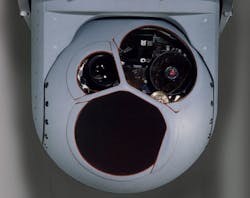Lockheed Martin to design advanced helicopter turret electronics for AH-1Z targeting pod
CRANE, Ind. 22 Oct. 2015. U.S. Navy aviation experts are asking Lockheed Martin Corp. to design and build advanced helicopter turret electronics for precise control of a state-of-the-art electro-optical sensor and targeting pod aboard the U.S. Marine Corps AH-1Z Viper attack helicopter.
Officials of the Naval Surface Weapons Center-Crane in Crane, Ind., have announced a $9.6 million contract modification to the Lockheed Martin Missiles and Fire Control segment in Orlando, Fla., to design the Turret Electronic Unit (TEU) versatile performance switching version.
The TEU is a component of the Target Sight System (TSS) aboard the Marine Corps AH-1Z attack helicopter, which provides target identification and tracking, and passive targeting for weapons like the Hellfire air-to-ground missile. The Viper helicopter's TSS has a laser-designator to help direct U.S. and allied laser-guided munitions. friendly laser-guided weapons.
This TEU order includes test equipment station; circuit card assembly; test and measurement; and engineering drawings. The contract modification is in response to an engineering change proposal that Lockheed Martin suggested for integrating the new Target Sight System aboard the AH-1Z Venom helicopter.
The Navy is awarding the contract modification to Lockheed Martin sole-source because Lockheed Martin is the original equipment manufacturer of the TEU and the TSS. Lockheed Martin needs to do some non-recurring engineering to fit the new TEUs on the AH-1Z helicopters to function properly with the new Target Sight Systems.
The TSS integration into AH-1Z Viper attack helicopter is part of the Marine Corps H-1 upgrades program, which is rebuilding legacy AH-1W SuperCobra attack helicopters and UH-1N Twin Huey utility helicopters with state of the art designs.
The H-1 program is converting AH-1W SuperCobra attack helicopters to AH-1Z Viper helicopters, and is converting UH-1N Twin Huey utility helicopters to UH-1Y Venom helicopters.
On this contract modification Lockheed Martin will do the work in Orlando, Fla.,; and Ocala, Fla., and should be finished by June 2017. For more information contact Lockheed Martin Missiles and Fire Control online at www.lockheedmartin.com/us/mfc, or the Naval Surface Weapons Center-Crane at www.navsea.navy.mil/Home/WarfareCenters/NSWCCrane.

